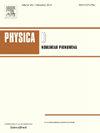类dtt托卡马克等离子体X点附近的湍流特征:静电和电磁流体模拟
IF 2.9
3区 数学
Q1 MATHEMATICS, APPLIED
引用次数: 0
摘要
必须设计托卡马克等离子体边缘的背景磁几何形状,以减轻主要由湍流输运引起的粒子和能量损失。ENEA Frascati正在建设的转向托卡马克测试(DTT)设施将测试几种磁性配置和缓解策略,这些策略通常基于存在一个或多个X点的非平凡拓扑的实现。为了清楚地了解其中一个X点附近的湍流输运,我们在类似dtt的情况下对托卡马克边缘等离子体进行了三维流体模拟。我们将概述:(1)通过与Cianfrani和Montani(2024)的论文结果的对比分析,得到湍流谱特征及其对某些模型参数(背景压力梯度和扩散系数)和磁几何的依赖关系;(2)小尺度极向结构与环向不对称之间的联系;(四)径向狄利克雷边界条件对纬向流动的激励的关键作用,纬向流动可以屏蔽磁场的径向分量;(五)磁场波动的影响。本文章由计算机程序翻译,如有差异,请以英文原文为准。
Turbulent features near the X point of a DTT-like tokamak plasma: Electro-static and electro-magnetic fluid simulations
The background magnetic geometry at the edge of a tokamak plasma has to be designed in order to mitigate the particle and energy looses essentially due to turbulent transport. The Divertor-Tokamak-Test (DTT) facility under construction at ENEA Frascati will test several magnetic configurations and mitigation strategies, that are usually based on the realization of nontrivial topologies in which one or more X points are present. In order to get a clear understanding of turbulent transport near one of such X points, we perform 3D fluid simulations of tokamak edge plasma for a DTT-like scenario. We will outline: (i) the resulting turbulent spectral features and their dependence on some model parameters (the background pressure gradients and diffusivity) and on the magnetic geometry through a comparative analysis with the results of the companion paper Cianfrani and Montani (2024), (ii) the connection between small scale poloidal structures and toroidal asymmetries, (iii) the formation of quiescent regions, (iv) the crucial role of radial Dirichlet boundary conditions for the excitation of zonal flows that can screen the radial component of the magnetic field, (v) the impact of magnetic fluctuations.
求助全文
通过发布文献求助,成功后即可免费获取论文全文。
去求助
来源期刊

Physica D: Nonlinear Phenomena
物理-物理:数学物理
CiteScore
7.30
自引率
7.50%
发文量
213
审稿时长
65 days
期刊介绍:
Physica D (Nonlinear Phenomena) publishes research and review articles reporting on experimental and theoretical works, techniques and ideas that advance the understanding of nonlinear phenomena. Topics encompass wave motion in physical, chemical and biological systems; physical or biological phenomena governed by nonlinear field equations, including hydrodynamics and turbulence; pattern formation and cooperative phenomena; instability, bifurcations, chaos, and space-time disorder; integrable/Hamiltonian systems; asymptotic analysis and, more generally, mathematical methods for nonlinear systems.
 求助内容:
求助内容: 应助结果提醒方式:
应助结果提醒方式:


